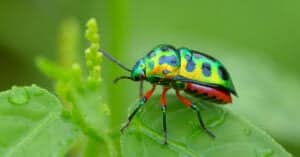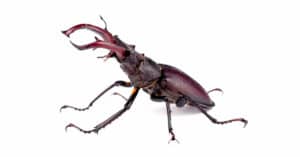
Beetles are the most common type of insect in the entire world. Humans have identified over 350,000 species of beetles that live on the planet. More are waiting to be discovered. One of the easiest ways to organize such numerous and unique insects is according to their color. Take a look at 10 types of orange beetles found throughout the world.
Learn where they’re from, how big they grow, and what danger they pose to humans and plants throughout their range.
1. Ten-Lined June Beetle

They go by the name watermelon beetles and have very poor eyesight, which is why they are so attracted to lights.
©GypsyPictureShow/Shutterstock.com
Polyphylla decemlineata is called the ten-lined June beetle and it may also be called the watermelon beetle. The pattern of their colors makes them resemble a watermelon. As their name suggests, ten-lined June beetles have several white lines that run down the length of their bodies.
They can appear in orangish-red, red, black, and some other colors. The species grows about 0.8 to 1.5 inches in total length, so they’re quite large. The beetles live in the United States and Canada.
2. Soldier Beetle
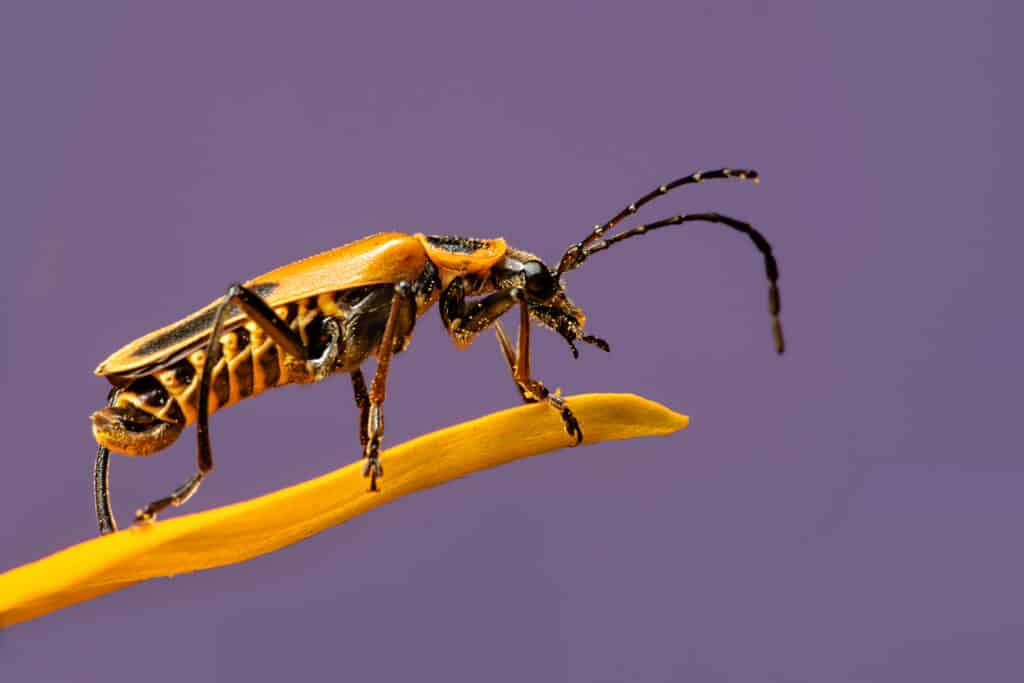
Soldier beetles are beneficial insects as they help pollinate flowers and get rid of insect pests.
©Muskoka Stock Photos/Shutterstock.com
The term soldier beetle applies to species that belong to the family Cantharidae. At first glance, these beetles resemble fireflies. However, these types of orange beetles are not bioluminescent. Soldier beetles can vary in appearance, but many of them feature the colors black and orange. Other colors include yellow and, to a lesser extent, brown.
These beetles are medium-sized, measuring about half an inch at their greatest length. Unlike most beetles a person finds in their garden, soldier beetles serve an important purpose. They consume insects that could become pests along with pollen and nectar.
3. Grapevine Beetle

The Grapevine beetle is a type of Scarab beetle.
©Paul Reeves Photography/Shutterstock.com
Pelidnota punctata are called Grapevine beetles. These beetles live in the United States and Canada, and they grow about 1 to 1.2 inches long. They’re known for feeding on grapevine leaves as adults. Their feeding doesn’t necessarily kill the plant, so grapevine beetles are not always considered pests.
The beetles have orange or yellow-orange elytra, thoraxes, and heads. Their colors aren’t solid, though. The beetle has several black dots across its body. Sometimes, they’re called a spotted June beetle.
4. Banded Net-Winged Beetle

The wings of this beetle resemble fishing nets.
©EM-80/Shutterstock.com
The banded net-winged beetles are named after the unique appearance of their wings. The intricate pattern on the elytra looks like nets. Also, the wings have bands of color, most often orange and black.
These beetles live in the eastern portion of the United States. At least, they’re often found to the east of the Rocky Mountains. Their range stretches from Mexico to the easternmost portions of Canada and most states in the U.S. They’re medium-sized beetles, only growing about 0.5 to 0.75 inches long.
5. Varied Carpet Beetle
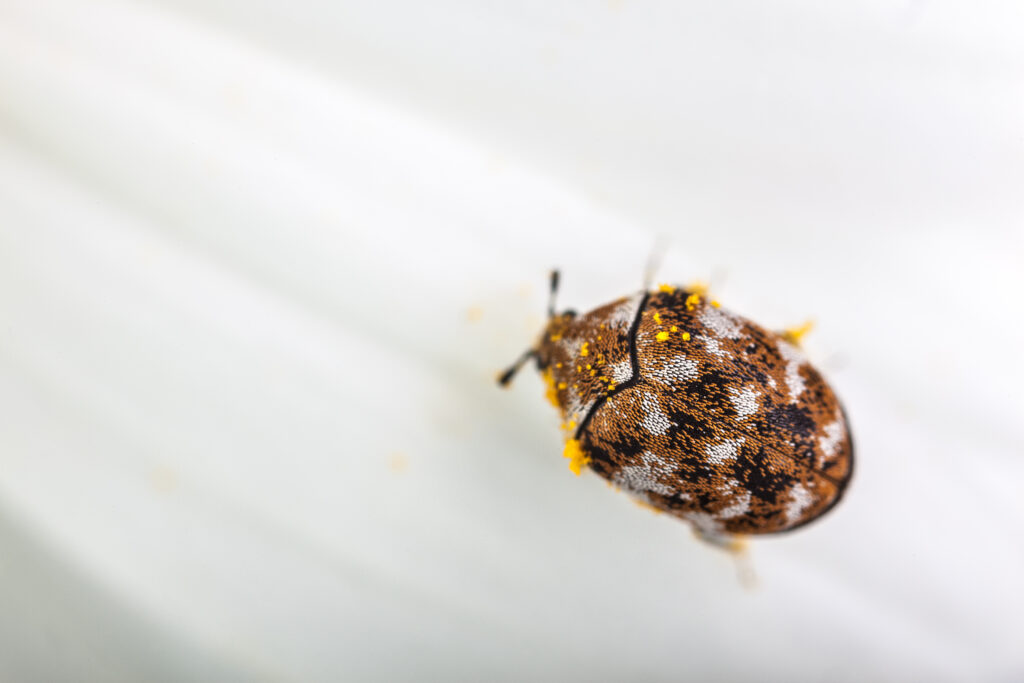
The varied carpet beetle has a gorgeous pattern, but it also has a bad habit of ruining carpets.
©iStock.com/porpeller
The varied carpet beetle (Anthrenus verbasci) is a small insect. Typically, they only grow about 0.1 to 0.2 inches long. So, they’re small enough that humans can overlook them completely. They’re certainly among the smallest types of orange beetles around.
These beetles are found throughout the entirety of North America. The varied carpet beetle is a domestic pest because they consume chitin and keratin. They often lay their eggs and hatch in home settings where they can access a variety of foods. Unfortunately, the beetles often eat carpets, blankets, bits of furniture, and more.
They appear in many colors, often with scaly-looking elytra with irregular patterns of orange, yellow, brown, white, and more.
6. Maize Weevil
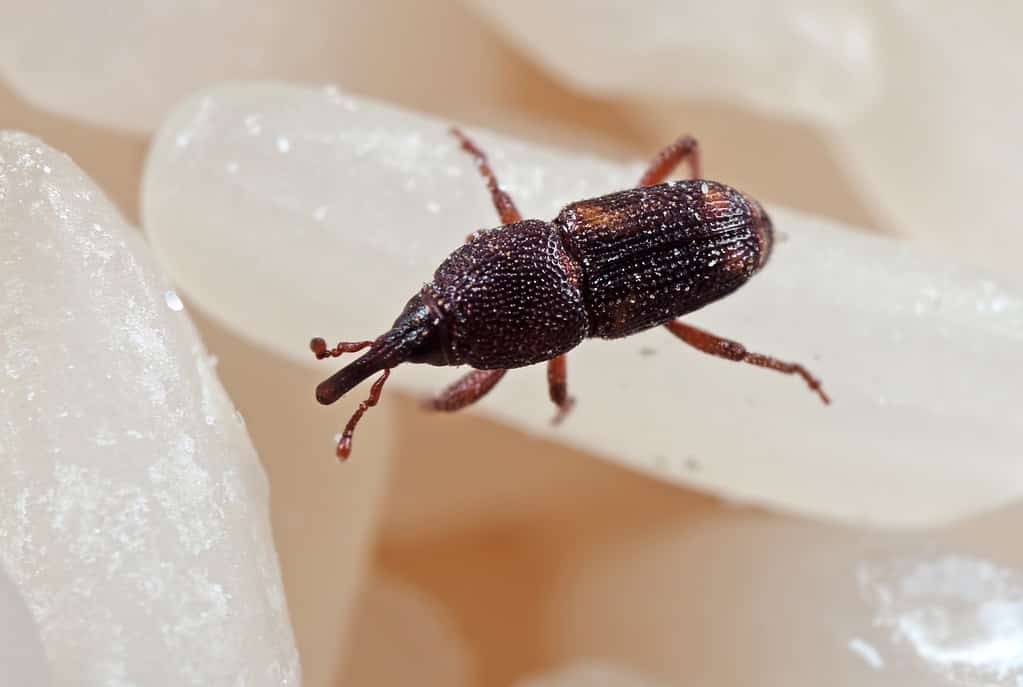
A maize weevil has some orange coloration.
©Cherdchai Chaivimol/Shutterstock.com
The maize weevil is a major pest around the world. Typically, the beetle focuses on maize, also known as corn. Yet, it doesn’t stop there. The beetle will often eat various other stored and standing crops including wheat, barley, and more.
The weevils mostly appear brown. However, some of them can be orange or red as well. These critters, like other weevils, have long snouts and very small bodies. Measuring a little more than a tenth of an inch, it’s easy for untrained eyes to miss these beetles on plants.
7. Earth-Boring Scarab Beetle
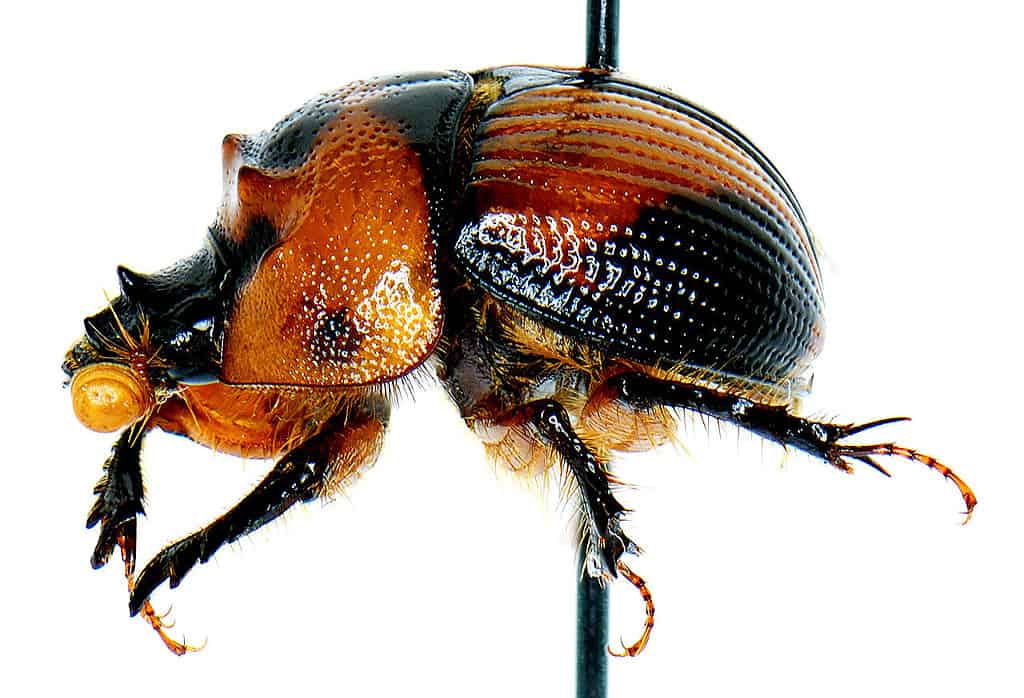
©Michael K. Oliver, Ph.D. / CC BY-SA 4.0, Wikimedia Commons – License
Several members of the Bolbocerasoma genus are called referred to as earth-boring scarab beetles. In this case, these insects are medium-sized beetles that measure about half an inch in total length. They have dome-shaped bodies, and they’re known for digging several feet into the ground.
Members of this genus have horn-like protuberances on their heads. They often appear in the colors black and orange, sometimes with spots on their elytra.
8. Asian Multicolored Lady Beetle
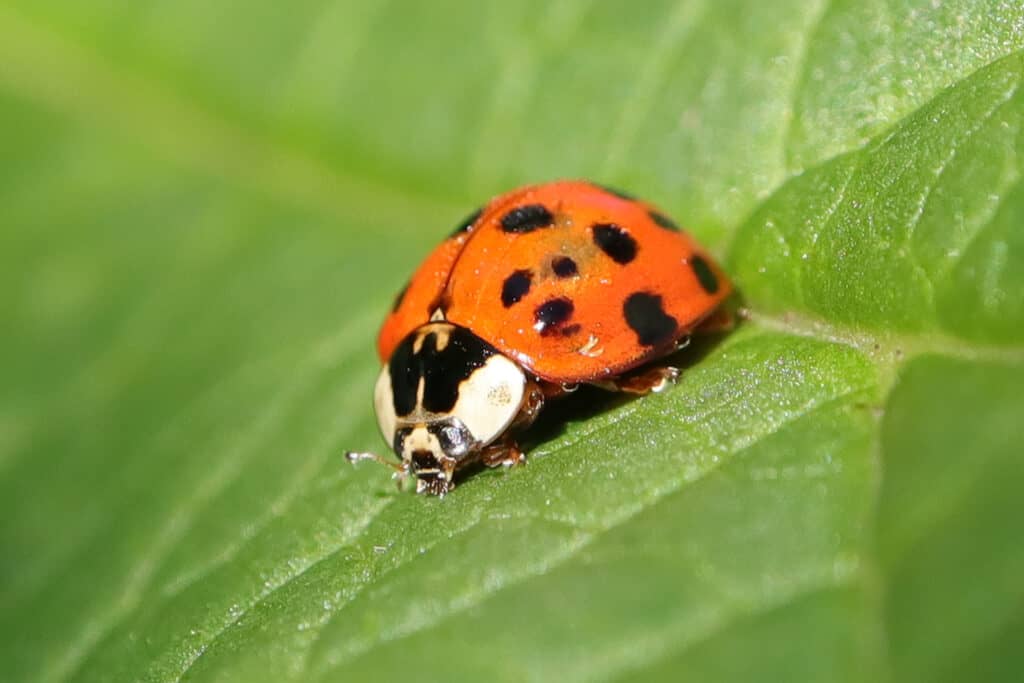
Ladybugs are also known as lady beetles and ladybird beetles.
©iStock.com/DE1967
Harmonia axyridis is known as the Asian multicolored lady beetle. People often mistake them for the convergent ladybugs (Hippodamia convergens) that are synonymous with the term “ladybug.” These are some of the most recognizable types of orange beetles.
The Asian multicolored lady beetle can appear orange, tan, black, or yellow. They often have black spots across their elytra. These particular insects can apparently bite, but they don’t cause serious harm. Also, they only grow to be about a quarter of an inch long, so they’re not very big. Still, many of them can infest an area, making them pests.
9. Stag Beetle
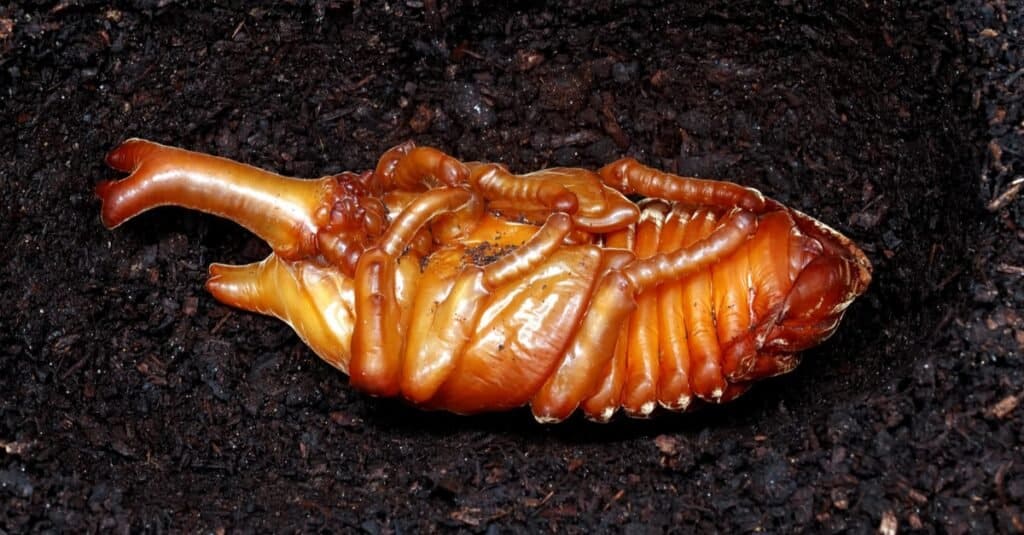
The pupa of coconut
rhinoceros
beetle in the ground. The pupa is the third stage in the life cycle of a beetle.
©topimages/Shutterstock.com
The term stag beetle refers to over 1,000 species of beetles contained in the family Lucanidae. Many of the species in this group grow from about 2 inches long, but some of the largest can reach over 4 inches long.
In particular, Lucanus capreolus is a specie of stag beetle often called the reddish-brown stag beetle. The creature can grow quite large, about 1.5 inches at its largest. While their elytra, thorax, and head are reddish-brown in color, the beetles are also orange on their legs.
Although the stag beetle has a very large mandible on its head, the chances are that it won’t bite a human with it.
10. Pennsylvania Leatherwing Beetle
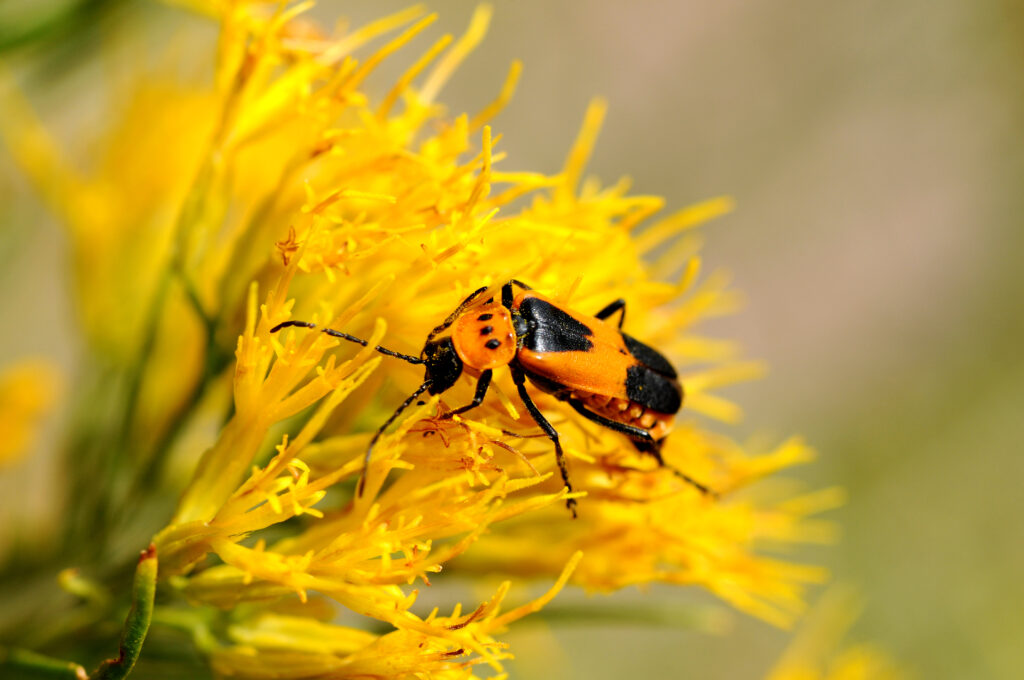
The Pennsylvania leatherwing beetle has wings that look like leather!
©Sean Xu/Shutterstock.com
The Pennsylvania leatherwing beetle is known for its orange elytra with black markings on each wing. The dull shine and smoothness of the wings make them appear like leather. While the pattern on their abdomens can resemble a bee, they’re not harmful creatures.
Instead, they are very helpful with pest control. They eat aphids, the little bugs that drive gardeners up the wall. These beetles grow about half an inch long at their greatest size. They’re generally found in the eastern portion of North America, including Mexico, east of the Rockies in the U.S., and eastern Canada.
There are not as many types of orange beetles as there are black or brown beetles. Still, these critters stand out amidst the vegetation. While some of them are harmful to gardens, others are very helpful at ridding gardens of pests. Learn about the beetles near your home to find out what ones you can leave alone and which ones need to be eliminated to save your garden.
Summary of the 10 Types of Orange Beetles
Here are 10 Types of Orange Beetles:
| Rank | Orange Beetles |
|---|---|
| 1 | Ten-Lined June Beetle |
| 2 | Soldier Beetle |
| 3 | Grapevine Beetle |
| 4 | Banded Net-Winged Beetle |
| 5 | Varied Carpet Beetle |
| 6 | Maize Weevil |
| 7 | Earth-Boring Scarab Beetle |
| 8 | Asian Multicolored Lady Beetle |
| 9 | Stag Beetle |
| 10 | Pennsylvania Leatherwing Beetle |
The photo featured at the top of this post is © Mr. Background/Shutterstock.com
Thank you for reading! Have some feedback for us? Contact the AZ Animals editorial team.



